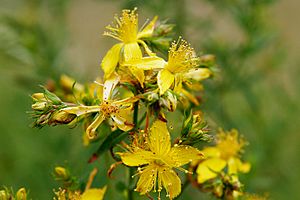Axbridge Hill and Fry's Hill facts for kids
|
||||||||||||
Axbridge Hill and Fry's Hill are two special hills in Somerset, England. They cover about 64.8 hectares, which is like 160 football fields! These hills are part of the beautiful Mendip Hills and are located right above the town of Axbridge. In 1990, they were officially recognized as a "Site of Special Scientific Interest" (SSSI). This means they are super important for nature, especially for their plants and animals.
Contents
Exploring Axbridge Hill and Fry's Hill
Axbridge Hill and Fry's Hill are found on the southern edge of the Mendip Hills. They are just east of another well-known spot called Shute Shelve Hill. This area is very important for its unique plant life and is also a home for some rare animals, including bats and many types of butterflies.
Incredible Plants and Flowers
This area is a treasure chest for plant lovers! You can find many different types of plants here, both big ones (called vascular plants) and smaller ones like mosses (called non-vascular plants). The soil on these hills is very thin, but it helps some really rare plants grow.
Some of the special plants you might find include:
- Cheddar bedstraw (Galium fleurotii): This plant is nationally rare, meaning it's very hard to find anywhere else in the country.
- Pale St John's wort (Hypericum montanum): This is one of four nationally scarce species found here.
- Sea storksbill (Erodium maritimum): Another scarce plant that thrives in these conditions.
- Dwarf mouse-ear (Cerastium pumilum): A small, rare flower.
- Spring cinquefoil (Potentilla tabernaemontani): This plant is also nationally scarce.
Home to Rare Animals
Axbridge Hill and Fry's Hill are not just for plants; they are also a vital home for many animals, especially bats and butterflies.
Bats in the Hills
The hills are a very important roosting (sleeping) spot for two types of bats that are nationally rare:
- Greater horseshoe bat (Rhinolophus ferrumequinum)
- Lesser horseshoe bat (Rhinolophos hipposideros)
These bats are protected because their numbers are very low across the country.
Other Amazing Wildlife
You can also find dormice (Muscardinus avellanarius) living in the woodlands on the hills. These tiny, sleepy creatures are known for hibernating for a long time.
The area is also a fantastic place for butterflies! Twenty-five different kinds of butterflies have been seen here, including:
- Brown argus (Aricia agestis)
- Green hairstreak (Callophrys rubi)
- Dark green fritillary (Argynnis aglaja)
- Marbled white (Melanargia galathea)
These beautiful insects add to the natural wonder of Axbridge Hill and Fry's Hill.


